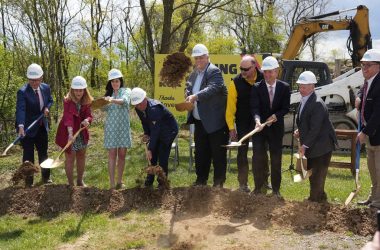By SUZANNE STEWART
The Pocahontas Times
It was a gorgeous day for a celebration Saturday as employees and guests gathered at Watoga State Park for the park’s 80th anniversary.
The past mingled with the present through stories shared about the beginnings of the park and the good times had over the years.

(Photo by Suzanne Stewart)
Watoga State Park naturalist Chris Bartley gave a history lesson on the park, which was created by the Civilian Conservation Corps – or CCC, a public work relief program founded as part of the New Deal in the 30s and 40s.
“There were originally three CCC camps here – Camp Watoga and Camp Seebert were the two most prominent,” Bartley said. “Camp Watoga was based where Beaver Creek campground is now and Camp Seebert was based where the riverside cabin area is. Each of these camps would have had roughly about one hundred and fifty men, aged eighteen to twenty-four, and they did a lot of work in this park – trail work, different buildings, the pool, the lake, the dam, the superintendent’s residence. All sorts of things.”
The CCC camp began work in 1934 and on July, 1937, Watoga park was opened to the public. The CCC boys continued to work at the park until the early 40s, when they were called to serve their country in World War II.
“The pool was the last major project that Camp Watoga was in charge of and after that, World War II broke out and all these young men were forced to go overseas to fight,” Bartley said.
Even prior to the war, the funding for CCC camps was dwindling and by the time the men returned from overseas, the program was gone.
“The funding was starting to dwindle in the late thirties,” Bartley said. “It was costing more and more tax dollars and then people were starting to lose interest. When World War II broke out, it was on hold and everybody went overseas to fight and so the program just basically disappeared right after that.”
When the young men were at work in Watoga, they earned $30 a month, most of which was sent back home to their families. The men were supplied uniforms, housing and meals, so they kept a few dollars for themselves for splurges, but they were mainly concerned with providing for their families.
“To be a CCC boy, you had to be between the ages of eighteen and twenty-four,” Bartley said. “There were records of some of them that even lied about their age. The youngest that I’ve seen as far as on record was fourteen-years-old. Desperate times called for desperate measures.”
Some of the items the young men would buy included shoes for four dollars, a nice sit- down dinner for one dollar, a loaf of bread for two cents and a pound of bacon for 38 cents.
There is a CCC museum at the park office which showcases photographs of the young men at work and play, as well as several personal items which were donated by family members.
In one display case, there are two footlockers owned by Donald Wilson and the Hager family. In another case are two of Wilson’s uniforms. On the inside of the lids of the footlockers, the boys kept track of the camps where they worked.
“[Wilson] did serve here at the park,” Bartley said. “He was part of Camp Watoga. This is his footlocker on this side, and you can see all the different areas where he served. This one was owned by the Hager family. They now reside in North Carolina, but you can see where it was passed from one person to the next. It stayed in the same family and they were all at different camps throughout the states.”
All items on display at the museum are authentic to the time and are now owned by Watoga State Park. Bartley said he has found more items he would like to display and hopes to receive grant funding to expand the museum.
“I’ve got newspapers from 1934 when the camp was started, all the way to 1940, so I want to find a way to properly display them without damaging them,” he said.
After the CCC camp was disbanded, Watoga State Park continued to thrive and has attracted thousands of visitors through the years.
To Bartley, the park has made it this far because of the history and the beauty that Watoga has to offer.
“Watoga has a very rich history as far as bringing people in, and people love to come here,” he said. “Whether it’s their first time or they’ve been coming year after year, generation after generation, I always like to hear people talk about what it is that keeps them coming back, and a lot of them tell me that it’s the atmosphere. They just love the solitude.”
As visitors gathered at the picnic pavilion to celebrate the anniversary with cake and punch, the love for Watoga was palpable as stories were shared with excited tones.
Bob Welch, of Williamstown, was one who visited Watoga, from his childhood to adulthood. His first visit to Watoga was with his parents when he was age four. Sixty years later, he was there for the park’s anniversary.
“I just like it so much,” he said. “I like the air. I like the altitude. I like the people. I like the trees. I like the water. I like the way things are set up. I like the whole thing. It’s different than other parks in a lot of ways.”
Two couples – Harold Thomas and Sylvia Elmore, and Joe and Peg Greenly – have also had their share of visits to Watoga.
Harold Thomas worked at Watoga for eight summers – during high school and college – and met Joe and Peg when they spent their honeymoon at the park.
“Those were eight wonderful summers for me as a high school and college boy,” Harold Thomas said. “Mr. [Kermit] McKeever hired me, and I worked with him four summers and then two other superintendents, two times. Lots of stories to tell.”
Peg reminded him of one of those stories that took place during the Greenly’s honeymoon.
“He’s the one that got a group together and belled us,” Peg said.
“It’s like serenading,” Harold Thomas explained. “You go and you take pots and pans and sticks and saw blades and hammers and we rouse them up about midnight.”
“It scared me to death,” Peg said, laughing. “I didn’t know what was going on.”
The Elmores now reside in Buckhannon, but maintain the home place in Seebert, and the Greenly’s are from Charleston, but also have a place at Seebert.
The couples have a lot in common, including honeymoon locations. When Harold Thomas and Syliva married, they also chose to stay at the park.
“In December,” Sylvia stressed.
As the four reminisced, they animatedly shared stories of times gone by.
“Down where the bridge is now, before the low water bridge, there was a flat bottom wooden boat big enough to put a car on,” Joe said.
“It was a ferry,” Harold Thomas interjected.
“There was a cable stretched across the river and then there was a handle grip – you hooked on to the cable and you walked to the back of the ferry,” Joe said. “That’s the way you took your car across the river. One spring, the flood took the ferry out so then it became a ford. If the water was low enough, you could drive your car across. The next step was the low water bridge.”
Harold has a scrapbook of photos from his time days of working at Watoga. He recalled his co-workers, including Devil Anse Hatfield, the great-grandson of the infamous West Virginian with the same name.
Many of his stories were recalled with such detail, it seemed as though they only happened weeks ago.
“Monday morning was the busiest morning,” Harold Thomas said. “They sold Ripco ice cream from Ronceverte, and it was ice cream on a stick. You dropped your stick in the parking lot. If you smoked cigarettes, you’d put your stub there. So every Monday morning, I’d be picking up stubs and sticks. I think ‘why didn’t I wear rubber gloves or have a stick with a nail in the end of it.’”
No matter what type of work he had to do, Harold Thomas said his time at Watoga was life-changing.
“Wonderful experience,” he said.
During the celebration, park superintendent Jody Spencer encouraged visitors to share their stories in a scrapbook provided by the park, so those memories can stay at Watoga.
To commemorate the occasion, the group gathered on a hill near the picnic pavilion and posed for a photograph – creating yet another memory.
See more from The Pocahontas Times




